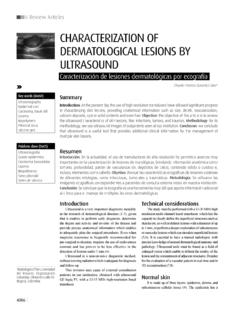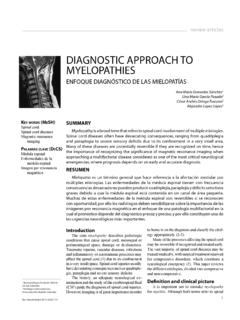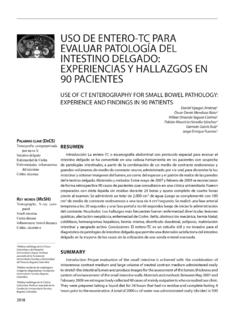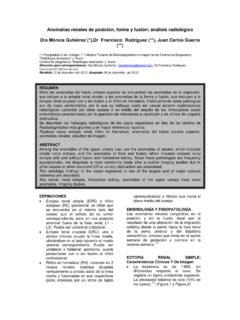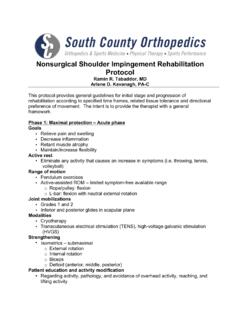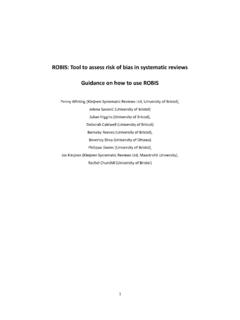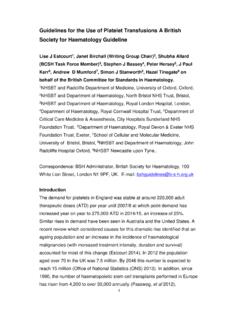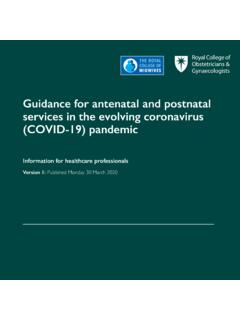Transcription of TI-RADS classification of thyroid nodules based on a score ...
1 TI-RADS classification of thyroid nodules based on a score modified according to ultrasound criteria for malignancyOriginalRev. Argent. Radiol. 2014;78(3): 138-148138 AbstractObjective: The classification system of the thyroid nodules (TN) TI-RADS ( thyroid Imaging Reporting and Data System) proposed by Horvath et al. in 2009 is rarely used. The aim of this study was to evaluate a score modified according to ultrasound (US) criteria for malignancy in order to obtain a better application of this classification in daily and methods: 3650 TNs were classified according to a score of potential malignancy. US criteria for suspected malignancy were defined according to published studies and guidelines from various medical international societies.
2 Each criterion was assigned a point for the final score of malignant probability of the TN. If suspected cervical lymph nodes were detected, a point was : The score in all benign ( TI-RADS 2) or probably benign ( TI-RADS 3) thyroid nodules was zero. In the TI-RADS 3 group only of the TNs were malignant. The scores of TI-RADS 4a, 4b and 4c were one, two and three to four points, respectively. The malignancy rates were , 48% and 85%, respectively. TI-RADS 5 TN had a score of five or more points with a malignancy of 100% in this : A TI-RADS classification based on a score according to the number of suspicious US criteria defined for malignancy can be applied in daily practice. 2014 Sociedad Argentina de Radiolog a.
3 Published by Elsevier Spain, All rights nodule; TI-RADS ; ultrasound ; thyroid scintigraphyIntroductionThyroid nodules (TNs) may show highly diverse ultrasound patterns1,2, which often impairs an accurate classification regarding malignancy. For this reason, in 2009 Horvath et al3 proposed an evaluation system for TNs called TI-RADS ( thyroid Imaging Reporting and Data System), similar to the Breast Imaging Reporting and Data System (BI-RADS)4,5. In 2011, Kwak et al6, complemented this classification adding one , both systems are difficult to apply. Even if the TI-RADS classification is quoted in the medical literature, it is rarely used in daily practice, perhaps because of some un-certainty on the part of the various specialists that use such aim of this study was to evaluate an easy-to-use TI-RADS classification based on a modified score according to the US criteria for malignancy present in each and methodsWe reviewed the 7960 thyroid ultrasound scans performed between 2003 and 2013 and stored on the Picture Archiving and Communication System/Radiology Information System (PACS/RIS).
4 The scans had been performed, or reviewed prior to reporting (if performed by a resident physician), by special-ists with 5 to 30 years experience in thyroid ultrasound . The US examination of a detected TN consisted in an evaluation of its echogenicity, internal content (presence of cystic lesions and/or calcifications), margins, shape and vascular pattern. based on studies and guidelines from various national and international medical societies of different specialties7-16, ul-trasound criteria for suspected malignancy were established (table 1). Each criterion was assigned a point, and an ad-ditional point was added when one or more cervical lymph nodes suspicious for malignancy were detected.
5 Thus, a final score of malignant probability of a TN was classification of thyroid nodules based on a score modified according to ultrasound criteria for malignancyJ. Fern ndez S nchez *Radiology and Nuclear Medicine, Robert-Bosch-Krankenhaus, University Hospital, T bingen University, Stuttgart, GermanyTI-RADS classification of thyroid nodules based on a score modified according to ultrasound criteria for malignancyRev. Argent. Radiol. 2014;78(3): 138-148J. Fern ndez S nchez139 For TI-RADS assessment, we selected from the PACS imag-ing archiving system appropriately documented TNs (sagittal and axial ultrasound images of TNs, obtained by convention-al --B mode-- imaging and by color Doppler for the evalua-tion of perfusion) of which fine needle aspiration (FNA) had been performed and/or which had been scanned by thyroid scintigraphy and/or elastosonography and/or other imaging method (magnetic resonance imaging [MRI], positron emis-sion tomography computed tomography [PET/CT])
6 And/or which had undergone histological assessment after surgery and/or which had at least a one-year clinical follow-up with ultrasound this was primarily a retrospective study, no approval was requested from the Ethics statistical analysis was based on the calculation of predic-tive values of the TI-RADS classification the 7960 thyroid ultrasound scans evaluated, one or sev-eral TNs were detected in 6127 and no focal lesions were de-tected in 1833. Of the latter (n = 1833), 1454 cases showed diffuse abnormality of the thyroid parenchyma, either due to Hashimoto s thyroiditis or to thyroid autoimmune disease (Grave-Basedow disease), while the remaining 379 patients with no focal lesion had a normal sized gland, with an ultra-sound pattern that was hyperechogenic (in regard to muscle) and homogeneous, and with normal vascularity on color Doppler.
7 These normal ultrasound scans of the thyroid , with an incidence of in our series (379/7960 cases) were classified as TI-RADS 1, similar to BI-RADS classification of the breast (BI-RADS 1 = normal breast)4,5Of the 6127 patients with one or several TNs, 1148 met the study requirements. Of all TNs, 3650 were appropriately doc-umented and had been evaluated by the reference diagnostic methods. Therefore, they were used for the evaluation of TI-RADS classification in this these 3650 TNs, 1302 ( ) showed benign sono-graphic features: 73/1302 simple cysts2,17, 104/1302 TNs with a central cyst (type 1, according to Kim et al classification for partially cystic TNs)16, 56/1302 TNs with non-interrupted homogeneous peripheral calcification18 and 1069/1302 spongiform TNs2, 19,20.
8 based on their ultrasound pattern and the absence of ultrasound criteria for malignancy, these TNs had a score of zero. Furthermore, additional tests (FNA [n = 88] and/or histological examination after surgery [n = 132] and/or thyroid scintigraphy [n = 585] and/or elastosonogra-phy [n = 95] and/or MRI/PET/CT [n = 12] and/or clinical and sonographic follow-up of at least one year [n = 554] did not reveal malignancy. Thus, these 1302 TNs were classified as TI-RADS remaining 2194 TNs ( ) of the total of 3650 TNs with no ultrasound criteria for malignancy ( score of zero) appeared as: hyperechoic with or without small cystic ab-normalities (527/2194); and solid with peripheral vascularity and a mixed pattern of hypo, iso or hyperechoic spots and/or small cystic changes and/or macrocalcifications (1667/2194).)
9 Only 48 ( of 2194) were malignant (histologically con-firmed after surgery). In the remaining 2146, additional tests (FNA [n = 177) and/or histological examination after surgery [n = 569] and/or thyroid scintigraphy [n = 687] and/or elasto-sonograhy [n = 128] and/or MRI/PET/CT [n = 18] and/or clini-cal and ultrasound follow-up of at least one year [n = 843] did not reveal malignancy. This type of TN was classified as TI-RADS 3 ( , low probability of malignancy).In turn, 154/3650 TNs ( ) were assigned one or more points of potential malignancy (table 2). One-hundred and five of those TNs had a score of 1 and 10 of them were ma-lignant (10/105; ). In 12 of 25 TNs with a score of 2, thy-roid carcinoma was histologically detected (12/25; 48%) and in the case of TNs with a score of 3-4, malignancy increased up to 85% (12/14).]
10 With the aim of unifying terminology and considering the malignancy rates published by Horvath et al3 and Kwak et al6, thyroid nodules were classified as TI-RADS 4a when they had a score of 1 (malignancy below 10%), as TI-RADS 4b when they had a score of 2 (malignancy 10-50%) and as TI-RADS 4c when they had a score of 3-4 (malignancy 50-85%). In the remaining 120 TNs with a score of 4, no carcinoma was detected by the reference with a score of 5 or higher were classified as TI-RADS 5 (probably malignant, similar to the BI-RADS system). In our study, these TNs were histologically diagnosed as differenti-ated thyroid carcinoma (10/10; 100%). Histologically, thyroid Table 1: Sonographically suspicious criteria for malignancy.
